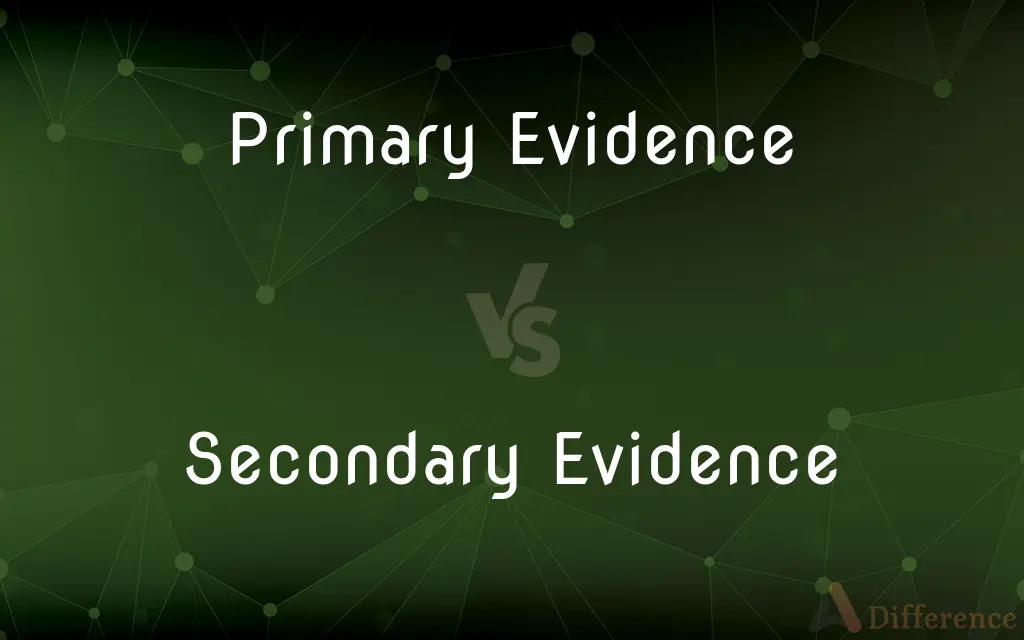Primary Evidence vs. Secondary Evidence — What's the Difference?
Edited by Tayyaba Rehman — By Fiza Rafique — Published on December 23, 2023
Primary Evidence is the original document; Secondary Evidence is a copy or substitute.

Difference Between Primary Evidence and Secondary Evidence
Table of Contents
ADVERTISEMENT
Key Differences
Primary Evidence refers to the main and original source of information or documentation that is presented to prove a certain fact or assertion. It is the firsthand evidence that is provided by a person who witnessed or experienced the event in question. On the other hand, Secondary Evidence is a reproduced, copied, or substitute form of the original evidence. It often acts as an alternative when the primary source is unavailable or lost.
The reliability of Primary Evidence is typically considered higher because it is the firsthand account, untouched and unchanged. Conversely, Secondary Evidence is approached with more caution since it is a replication and there might be room for inaccuracies. One key thing to note is that courts and legal proceedings usually prioritize Primary Evidence.
However, if Primary Evidence cannot be obtained, Secondary Evidence might be admissible under certain circumstances. It's essential to understand that while Primary Evidence is direct and firsthand, Secondary Evidence serves to corroborate, validate, or replace the primary form.
Comparison Chart
Nature
Original source of information
Reproduction or substitute of the original
Reliability
Generally more reliable
Considered less reliable due to potential inaccuracies
ADVERTISEMENT
Usage in Legal Systems
Prioritized in courts
Accepted when primary is unavailable
Form
Firsthand account
Indirect or derivative form
Examples
Original signed contract
Photocopy or digital scan of the contract
Compare with Definitions
Primary Evidence
Primary Evidence refers to firsthand accounts or records.
The eyewitness account of an accident is Primary Evidence.
Secondary Evidence
Secondary Evidence confirms or supports primary evidence.
A witness recounting someone else's testimony is Secondary Evidence.
Primary Evidence
Primary Evidence is the main source presented in legal matters.
The original signed will is Primary Evidence of a person's last wishes.
Secondary Evidence
Secondary Evidence is an alternative to the primary source.
A transcript of a conversation is Secondary Evidence of what was said.
Primary Evidence
Primary Evidence is unaltered and unchanged.
The original footage of an event is Primary Evidence of what occurred.
Secondary Evidence
Secondary Evidence comes into play when the original is unavailable.
A replica of a lost artifact is Secondary Evidence of its design.
Primary Evidence
Primary Evidence is the original piece of information.
For instance, an original manuscript is Primary Evidence of its content.
Secondary Evidence
Secondary Evidence is derived from the original piece.
A digital scan of a document is Secondary Evidence of its content.
Primary Evidence
Primary Evidence is direct proof of a fact or assertion.
The original painting is Primary Evidence of an artist's work.
Secondary Evidence
Secondary Evidence is a copy or reproduction of the original.
For example, a photograph of an artwork is Secondary Evidence of its existence.
Common Curiosities
What is Primary Evidence?
Primary Evidence is the original, unaltered source of information or document.
Is Primary Evidence always preferred over Secondary Evidence?
Yes, in legal proceedings, Primary Evidence is usually prioritized over Secondary Evidence.
When is Secondary Evidence accepted?
Secondary Evidence is accepted when Primary Evidence is lost, unavailable, or inaccessible.
Can photographs be considered Primary Evidence?
If the photograph is the original subject of proof, it's Primary Evidence. Otherwise, if it's capturing something else, it's Secondary.
Can Secondary Evidence ever become Primary Evidence?
No, Secondary Evidence remains secondary, but it can be primary evidence of its own existence or creation.
How does Secondary Evidence differ from Primary Evidence?
Secondary Evidence is a reproduction or substitute of the original, while Primary Evidence is the original piece itself.
Why is Primary Evidence seen as more reliable?
Primary Evidence is firsthand and unaltered, making it a direct source of truth.
What happens if Primary Evidence is lost?
If lost, Secondary Evidence can be presented, given it's admissible under the circumstances.
Why is Secondary Evidence used?
It's used when Primary Evidence is not obtainable or to support and corroborate Primary Evidence.
Can Secondary Evidence be in digital form?
Yes, digital scans or reproductions are examples of Secondary Evidence.
Is a verbal recount of a document Primary or Secondary Evidence?
It's Secondary Evidence as it's a derivative form of the original document.
Are digital copies always Secondary Evidence?
Generally, digital copies are Secondary Evidence as they are reproductions of the original.
Why is the distinction between Primary and Secondary Evidence important?
The distinction helps determine the reliability and admissibility of evidence in various contexts, especially legal ones.
What is an example of Secondary Evidence in a courtroom?
A photocopy of an original signed contract can serve as Secondary Evidence.
Is an eyewitness account Secondary Evidence?
No, an eyewitness account is Primary Evidence as it's a firsthand account of an event.
Share Your Discovery

Previous Comparison
Primary Immune Response vs. Secondary Immune Response
Next Comparison
Additive Colors vs. Subtractive ColorsAuthor Spotlight
Written by
Fiza RafiqueFiza Rafique is a skilled content writer at AskDifference.com, where she meticulously refines and enhances written pieces. Drawing from her vast editorial expertise, Fiza ensures clarity, accuracy, and precision in every article. Passionate about language, she continually seeks to elevate the quality of content for readers worldwide.
Edited by
Tayyaba RehmanTayyaba Rehman is a distinguished writer, currently serving as a primary contributor to askdifference.com. As a researcher in semantics and etymology, Tayyaba's passion for the complexity of languages and their distinctions has found a perfect home on the platform. Tayyaba delves into the intricacies of language, distinguishing between commonly confused words and phrases, thereby providing clarity for readers worldwide.
















































